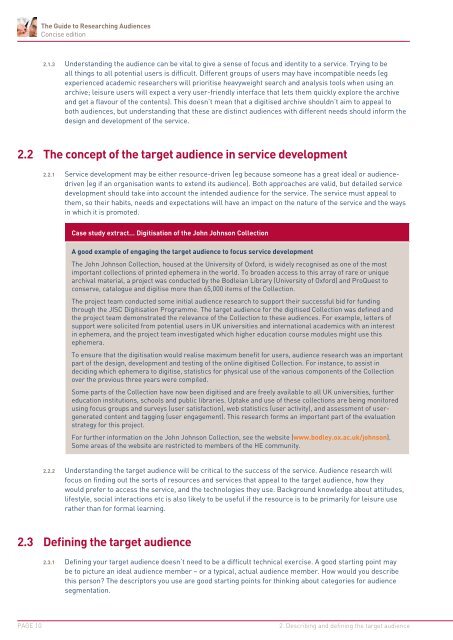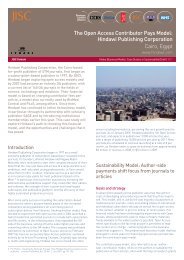A Concise Guide to Researching Audiences - Strategic Content ...
A Concise Guide to Researching Audiences - Strategic Content ...
A Concise Guide to Researching Audiences - Strategic Content ...
Create successful ePaper yourself
Turn your PDF publications into a flip-book with our unique Google optimized e-Paper software.
The <strong>Guide</strong> <strong>to</strong> <strong>Researching</strong> <strong>Audiences</strong><strong>Concise</strong> edition2.1.3 Understanding the audience can be vital <strong>to</strong> give a sense of focus and identity <strong>to</strong> a service. Trying <strong>to</strong> beall things <strong>to</strong> all potential users is difficult. Different groups of users may have incompatible needs (egexperienced academic researchers will prioritise heavyweight search and analysis <strong>to</strong>ols when using anarchive; leisure users will expect a very user-friendly interface that lets them quickly explore the archiveand get a flavour of the contents). This doesn’t mean that a digitised archive shouldn’t aim <strong>to</strong> appeal <strong>to</strong>both audiences, but understanding that these are distinct audiences with different needs should inform thedesign and development of the service.2.2 The concept of the target audience in service development2.2.1 Service development may be either resource-driven (eg because someone has a great idea) or audiencedriven(eg if an organisation wants <strong>to</strong> extend its audience). Both approaches are valid, but detailed servicedevelopment should take in<strong>to</strong> account the intended audience for the service. The service must appeal <strong>to</strong>them, so their habits, needs and expectations will have an impact on the nature of the service and the waysin which it is promoted.Case study extract… Digitisation of the John Johnson CollectionA good example of engaging the target audience <strong>to</strong> focus service developmentThe John Johnson Collection, housed at the University of Oxford, is widely recognised as one of the mostimportant collections of printed ephemera in the world. To broaden access <strong>to</strong> this array of rare or uniquearchival material, a project was conducted by the Bodleian Library (University of Oxford) and ProQuest <strong>to</strong>conserve, catalogue and digitise more than 65,000 items of the Collection.The project team conducted some initial audience research <strong>to</strong> support their successful bid for fundingthrough the JISC Digitisation Programme. The target audience for the digitised Collection was defined andthe project team demonstrated the relevance of the Collection <strong>to</strong> these audiences. For example, letters ofsupport were solicited from potential users in UK universities and international academics with an interestin ephemera, and the project team investigated which higher education course modules might use thisephemera.To ensure that the digitisation would realise maximum benefit for users, audience research was an importantpart of the design, development and testing of the online digitised Collection. For instance, <strong>to</strong> assist indeciding which ephemera <strong>to</strong> digitise, statistics for physical use of the various components of the Collectionover the previous three years were compiled.Some parts of the Collection have now been digitised and are freely available <strong>to</strong> all UK universities, furthereducation institutions, schools and public libraries. Uptake and use of these collections are being moni<strong>to</strong>redusing focus groups and surveys (user satisfaction), web statistics (user activity), and assessment of usergeneratedcontent and tagging (user engagement). This research forms an important part of the evaluationstrategy for this project.For further information on the John Johnson Collection, see the website (www.bodley.ox.ac.uk/johnson).Some areas of the website are restricted <strong>to</strong> members of the HE community.2.2.2 Understanding the target audience will be critical <strong>to</strong> the success of the service. Audience research willfocus on finding out the sorts of resources and services that appeal <strong>to</strong> the target audience, how theywould prefer <strong>to</strong> access the service, and the technologies they use. Background knowledge about attitudes,lifestyle, social interactions etc is also likely <strong>to</strong> be useful if the resource is <strong>to</strong> be primarily for leisure userather than for formal learning.2.3 Defining the target audience2.3.1 Defining your target audience doesn’t need <strong>to</strong> be a difficult technical exercise. A good starting point maybe <strong>to</strong> picture an ideal audience member – or a typical, actual audience member. How would you describethis person? The descrip<strong>to</strong>rs you use are good starting points for thinking about categories for audiencesegmentation.PAGE 102. Describing and defining the target audience



